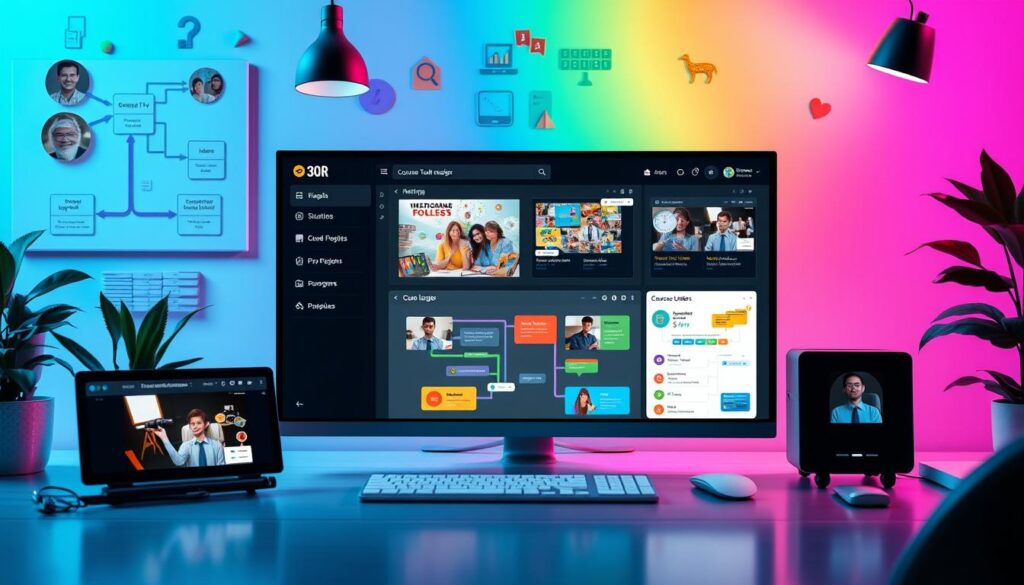In today’s digital world, online course creation tools have changed education. They make it easier for teachers to create engaging courses for online learning. Whether you’re a seasoned teacher or new to online teaching, the right tools can help a lot.
These tools offer everything from easy-to-use software to full-featured platforms. They help teachers make courses that are fun and interactive. This makes learning exciting for students and creates a lively classroom atmosphere.

Key Takeaways
- Online course creation tools revolutionize the way educators design and deliver content for remote learning environments.
- These tools simplify the content creation process and enhance student engagement with interactive features.
- The market offers a diverse range of e-learning authoring software and course builder platforms to meet the needs of modern educators.
- Choosing the right online course creation tool can unlock new possibilities for effective knowledge transfer.
- Investing in the right tools can streamline the course creation process and improve the overall learning experience.
Why Online Course Creation Tools Are Essential for Modern Education
In today’s fast-changing education world, online course tools are key for teachers and schools. They change how we teach and learn, making learning online better, more fun, and effective.
Impact on Remote Learning Success
The COVID-19 pandemic made online learning a must. Online course tools helped teachers teach well from home. They made sure students could keep learning, no matter where they were.
Benefits for Teachers and Students
Online tools help teachers and students a lot. Teachers get tools to make learning materials better and more fun. Students get to learn at their own pace, with cool features like videos and quizzes.
Cost-Effectiveness of Digital Teaching
Online tools are cheaper than old-school teaching. Schools save money on buildings and travel. This means they can spend more on making learning better for everyone.
As more people want flexible learning, online tools are vital. They help teachers give great, affordable, and engaging lessons. This is changing education for the better.
Understanding E-learning Authoring Software Basics
In today’s digital world, e-learning authoring software has changed how we make and share educational content. These tools help teachers and course makers create interactive, multimedia-rich learning experiences. They open up a world of possibilities, from making eye-catching visuals to adding fun interactive parts.
At the heart of e-learning authoring software is the ability to mix different media types like text, images, audio, and video. This makes learning more fun and engaging for students. The easy-to-use interfaces of these tools let even those who aren’t tech-savvy make complex, visually appealing courses.
Another big plus of e-learning authoring software is its support for interactive course creation. It offers many interactive elements, such as quizzes, simulations, and drag-and-drop activities. These features encourage students to be active and help them learn better. They make learning fun and keep students interested in the course.
Also, e-learning authoring software works well with learning management systems (LMS). This makes it easy to go from making content to delivering courses. It gives students a smooth learning experience, letting them access content, do assessments, and track their progress in one place.

In summary, e-learning authoring software is a key tool in today’s education. It lets teachers make engaging, interactive, and multimedia-rich courses. This has changed how we teach and learn, making education more effective and tailored to each student’s needs.
Top Features to Look for in Course Builder Platforms
Choosing the right course builder platform is key for your online teaching. It’s important to look at essential features that can boost your digital course success. Whether you’re looking at course builder platforms, learning management systems (LMS), or virtual classroom solutions, focus on these main features.
User Interface and Navigation
A good user interface (UI) is crucial for both teachers and students. Look for platforms with a clean, modern design. They should be easy to use, making it simple to find course materials and engage with the learning process. A user-friendly design encourages more participation.
Content Integration Capabilities
Top course builder platforms should let you easily add different types of content. This includes videos, images, quizzes, and more. This flexibility helps you create engaging courses that fit various learning styles.
Assessment and Testing Tools
Good assessment and testing tools are vital for checking student progress and giving feedback. Choose platforms with various testing options like quizzes and exams. They should also let you track student performance and offer personalized feedback.

“The right course builder platform can make all the difference in creating engaging and effective online courses.”
By focusing on these key features, you can find the best course builder platform for your teaching needs. This will help you provide a great learning experience for your students.
Most Popular Online Course Creation Tools in 2024
The world of digital education is changing fast. Now, more than ever, we need strong online course creation tools. In 2024, many new e-learning authoring software and instructional design tools have come out. They meet the needs of today’s teachers and creators.
Canva for Education
Canva for Education makes it easy for teachers to create beautiful course materials. It has lots of templates, graphics, and multimedia. This makes it a top choice for teachers who want to engage their students online.
Articulate Storyline
Articulate Storyline is a top e-learning authoring software. It lets teachers make interactive and fun online courses. Its easy-to-use design and strong features make learning exciting for students.
Google Classroom
Google Classroom is a free tool for managing digital courses. It works well with Google apps. It helps teachers organize assignments, start discussions, and work together with students.
| Tool | Key Features | Pricing | Target Audience |
|---|---|---|---|
| Canva for Education | Intuitive design tools, multimedia integration, collaboration features | Free for educators, paid plans available | K-12 and higher education teachers, instructional designers |
| Articulate Storyline | Extensive authoring capabilities, interactive content creation, assessments | Subscription-based, starting at $999 per author | Corporate trainers, higher education instructors, instructional designers |
| Google Classroom | Seamless integration with Google Suite, assignment management, discussion forums | Free for educators | K-12 and higher education teachers, administrators |
These tools are just a few examples of the many online course creation tools out there. As technology keeps improving, we’ll see even more options. These will help make learning better for everyone.

Comparing Free vs Paid Course Development Solutions
When making online courses, people often choose between free and paid options. Free choices are great for those watching their budget. But, spending on premium features can really pay off in the long run.
Budget-Friendly Options
For those with little money, tools like Google Classroom, Canva, and Zoom are good. They let you make and share courses without spending much. But, they don’t have as many features as paid options.
Premium Features Worth Investment
Paid online training development tools, like Thinkific, Teachable, and Kajabi, have more to offer. They have advanced content hosting services, interactive tests, and multimedia. They also work well with learning management systems (LMS). Even though they cost more upfront, they can make learning better and easier to manage.
ROI Considerations
Thinking about ROI is key when picking between free and paid tools. Free options might save money, but they might not grow with you. Paid tools, though more expensive, offer more support and features. This can lead to more students, higher success rates, and better learning experiences.

“Investing in a paid course development platform can be a game-changer, unlocking new possibilities for engaging and empowering your students.”
Interactive Elements and Multimedia Integration
In online course creation, multimedia and interactive elements are key. They make learning fun and effective. Educators use these tools to keep students engaged and help them learn better.
Quizzes and assessments are great for interactive learning. They check if students understand the material and give them feedback. Simulations and scenarios let students practice what they’ve learned in real-life situations.
- Quizzes and assessments for active learning
- Simulations and interactive scenarios for real-world application
- Embedded videos and multimedia content for enhanced visual learning
Adding multimedia like videos, animations, and infographics makes courses better. These elements grab students’ attention and help them understand complex topics better. Learning becomes more fun and effective.
| Interactive Feature | Benefit for Students | Benefit for Instructors |
|---|---|---|
| Quizzes and Assessments | Immediate feedback, improved retention | Measure student progress, identify knowledge gaps |
| Simulations and Scenarios | Hands-on learning, problem-solving practice | Enhance real-world relevance, foster critical thinking |
| Multimedia Integration | Enhanced visual learning, improved engagement | Diverse content delivery, increased course appeal |
By using interactive elements and multimedia, online courses can reach their full potential. This helps both students and teachers succeed in today’s education world.
“Integrating interactive elements and multimedia into online courses not only enhances student engagement but also drives deeper learning and retention.”
Content Hosting Services and Platform Security
Online course creation tools are changing how we teach and learn. It’s vital to have reliable content hosting services and strong platform security. In the world of online training development, keeping data safe and making sure students can access course materials is key.
Data Protection Measures
A secure online course platform starts with good data protection. Top content hosting services use advanced encryption, access controls, and follow strict standards. They also do identity checks, use two-factor authentication, and check for security issues often.
Storage Solutions
Good storage solutions are key for learning management systems (LMS) and online courses. Cloud-based hosting offers flexible, safe, and easy-to-get storage. This means course materials and student records are always available, no matter where you are or what device you use.
Backup Systems
Backup systems are a must to protect against data loss or system failures. They help get course content and student progress back if something goes wrong. Good content hosting services have solid backup plans, including automatic backups, version control, and off-site storage.
By focusing on strong data protection, flexible storage, and reliable backups, content hosting services help educators and schools offer top-notch, secure online learning. This builds trust and helps students succeed in the digital world.
Learning Management Systems Integration Guide
Integrating your online course tools with a Learning Management System (LMS) can change education. It connects your course builder and virtual classroom with an LMS. This brings many benefits for teachers and students.
This guide will show you how to integrate your tools with an LMS. You’ll learn about the advantages and how to overcome challenges. We’ll share insights and best practices to make your online courses better.
Whether you’re an experienced teacher or new to digital teaching, this guide has you covered. It will help you create a great learning experience for your students. Learn how to manage your courses better, engage your students more, and succeed in online education.
FAQ
What are the key features to look for in online course creation tools?
Look for a user-friendly interface and content integration. Also, consider assessment and testing tools, multimedia options, and LMS integration.
How do online course creation tools impact remote learning success?
These tools make learning fun and interactive. They let teachers create engaging content that students can access anywhere. This leads to better learning and more student interest.
What are the benefits of using online course creation tools for both teachers and students?
Teachers get more efficient and can update content quickly. They can also reach more students. Students enjoy interactive learning, quizzes, and multimedia, which helps them learn better.
How do the costs of digital teaching compare to traditional methods?
Digital teaching can save money in the long run. There are initial costs, but you can teach more students and save on physical space. This makes digital teaching more cost-effective.
What are the core functionalities of e-learning authoring software?
E-learning software lets you add multimedia, create interactive content, and test students. It also publishes courses easily. This makes creating online courses simpler and more engaging.
How do free and paid online course creation tools differ?
Free tools offer basic features like content creation and hosting. Paid tools have more advanced features like branding and analytics. Choose based on your needs and budget.
What are the key considerations for integrating online course creation tools with Learning Management Systems (LMS)?
Integration makes learning smoother and helps track courses better. Look at data syncing, user management, and content embedding. These ensure a seamless learning experience.
